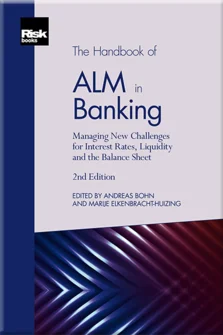Hedge Accounting
Bernhard Wondrak
Hedge Accounting
Introduction
Bank Capital and Liquidity
ALM in the Context of Enterprise Risk Management
The New Basel Standards on IRRBB and Their Implications for ALM
Measuring and Managing Interest Rate and Basis Risk
The Modelling of Non-Maturity Deposits
Modelling Non-Maturing Deposits with Stochastic Interest Rates and Credit Spreads
Managing Interest Rate Risk for Non-Maturity Deposits
Replication of Non-Maturing Products in a Low Interest Rate Environment
Managing Mortgage Prepayment Risk on the Balance Sheet
Considerations for ALM in Low and Negative Interest Rate Environments
Credit Spreads
Hedge Accounting
Supervisory Views on Liquidity Regulation, Supervision and Management
Measuring and Managing Liquidity and Funding Risk
Managing Reserve Assets
Instruments for Secured Funding
Asset Encumbrance
Capital Management
A Global Perspective on Stress Testing
Reverse Stress Testing: Linking Risks, Earnings, Capital and Liquidity – A Process-Orientated Framework and Its Application to Asset–Liability Management
XVAs and the Holistic Management of Financial Resources
Optimal Funding Tenors
Funds Transfer Pricing in the New Normal
Balance-Sheet Management with Regulatory Constraints
The hedge accounting principles are special accounting rules that were incorporated into International Accounting Standard 39 (IAS 39) to eliminate valuation asymmetries resulting from the specific valuation principles in the four categories of financial instruments in the original standard. Hedge accounting is applicable for hedges of financial instruments in the IAS 39 categories “loans and receivables”, “held to maturity” and “available for sale” with derivative instruments as hedging instruments. Although hedge accounting was introduced to consider risk management effects in financial accounting, it was characterised by many administrative obligations and limitations that restricted the use of the hedge accounting rules in banks.
In 2009 a project was set up to replace the IAS 39 by International Financial Reporting Standard 9 (IFRS 9). Hedge accounting rules in IFRS 9 were the third part of the replacement of IAS 39 after classification and measurement and the replacement of the impairment rules by expected credit loss. The final version of the hedge accounting rules for IFRS 9 was published on July 24, 2014, and endorsed by the European Union on November 29, 2016 (European
Copyright Infopro Digital Limited. All rights reserved.
As outlined in our terms and conditions, https://www.infopro-digital.com/terms-and-conditions/subscriptions/ (point 2.4), printing is limited to a single copy.
If you would like to purchase additional rights please email info@risk.net
Copyright Infopro Digital Limited. All rights reserved.
You may share this content using our article tools. As outlined in our terms and conditions, https://www.infopro-digital.com/terms-and-conditions/subscriptions/ (clause 2.4), an Authorised User may only make one copy of the materials for their own personal use. You must also comply with the restrictions in clause 2.5.
If you would like to purchase additional rights please email info@risk.net











